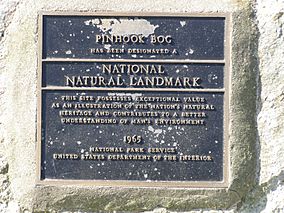Pinhook Bog facts for kids
Quick facts for kids Pinhook Bog National Natural Landmark |
|
|---|---|
 |
|
| Location | LaPorte County, Indiana, United States |
| Nearest city | Michigan City, Indiana |
| Area | 25 acres (100,000 m2) |
| Governing body | National Park Service |
| Designated: | 1965 |
Pinhook Bog is a special kind of wetland in Indiana. It's so unique that it has been named a National Natural Landmark. This means it's a very important natural place.
The bog is part of Indiana Dunes National Park. Many people worked hard to protect this area. Another similar bog, Volo Bog, is close by.
Pinhook Bog is home to many different plants. You can find plants that eat insects, tamarack trees, blueberry bushes, and even floating mats of squishy sphagnum moss. The bog is about 580 acres big. A quarter of it is a floating mat made of sphagnum peat moss. A "moat" (a wet ditch) separates the bog from the higher ground around it.
Contents
How Pinhook Bog Formed
Pinhook Bog is a "glacial kettle". This means it formed from a giant chunk of ice. About 14,000 to 15,000 years ago, during the end of the Ice Age, a huge piece of ice got buried here. When the ice melted, the clay soil underneath sealed the basin. This created a natural bowl that holds water.
Water in the Bog
The only water sources for the bog are rain and runoff from the higher ground nearby. No streams or underground water flow into or out of it. The only way water leaves is by evaporating from the open water and plants.
This limited water exchange makes a bog different from swamps, marshes, or ponds. The water in Pinhook Bog is still, acidic, and doesn't have many nutrients. This unique environment allows special plants to grow here.
Amazing Plants of Pinhook Bog
The most amazing thing about Pinhook Bog is its floating mat of sphagnum moss. This moss is light green and delicate. The mat floats on top of the water. It can be 3 to 6 feet thick, but some spots might be only a few inches thick.
As the mat gets thicker, bigger plants start to grow on it. Under the mat, a layer of peat forms. The acidic water slows down how fast the moss and other plants decay. Over a long time, the peat can fill the entire bog. If the water becomes less acidic, regular land plants can grow, and the bog might eventually disappear.
Beautiful Orchids
You can find several types of orchids in Pinhook Bog:
- Pink lady's slipper (Cypripedium acaule) is a beautiful flower that can be pink, deep rose, or white. It's the only lady's slipper orchid that doesn't have leaves on its stem. This plant can grow 12 to 18 inches tall.
- Yellow fringed orchid (Platanthera ciliaris) is a tall orchid with a flower cluster that can be 6 inches high. The whole plant can grow from 7 to 40 inches tall. Its flowers are yellow to orange.
- Rose pogonia (Pogonia ophioglossoides) is a small pink orchid. You can find it near the end of the boardwalk. This orchid is about 1 foot tall, and its flower is about 2 inches long.
Carnivorous Plants
Pinhook Bog is home to several amazing Carnivorous plants that eat insects!
- Spoonleaf sundew (Drosera intermedia) is a tiny plant. Its leaves are shaped like spoons or teardrops. They are covered in sticky, glue-tipped "tentacles" that trap insects.
- Round-leaved sundew (Drosera rotundifolia) is another tiny plant. It has round leaves covered in sticky, glue-tipped "tentacles" to catch insects.
- Purple pitcher plant (Sarracenia purpurea) has reddish or purple leaves with strong veins. These leaves are folded to form a pitcher or cup. The cup is usually half full of liquid that helps digest insects.
- Horned bladderwort (Utricularia cornuta) is a small carnivorous plant that grows on land. It has bladder-shaped traps that catch tiny soil insects. It's often noticed by its flower, as its leaves are very small.
- Hidden-fruited bladderwort (Utricularia geminiscapa) is a small carnivorous plant that lives in water. It has bladder-shaped traps that catch small aquatic insects.
Other Important Plants
- Poison sumac is common around the outer edge of the bog, near the "moat." Be careful! You can recognize it by its leaves, which have seven to thirteen smooth-edged, pointed leaflets.
- Tamarack or American larch is an unusual tree for this part of Indiana. It's a conifer, like a pine tree, but it's not an evergreen. Its needles turn golden in the fall and then drop off in the winter.
- You can also find Blueberry and cranberry shrubs along the edges of the bog. Rusty cotton grass grows farther down the trail.
Visiting Pinhook Bog
Pinhook Bog is open for special tours led by park rangers. Sometimes, there are also open houses. From the parking lot, a trail about 1/2 mile long leads you through the woods to the bog's entrance. The entrance is gated and locked when tours are not happening.
Inside the bog, you can walk along a plastic boardwalk that is about 1/4 mile long. It's very important not to step off the boardwalk. The bog's ecosystem is very fragile and can be easily damaged. As you walk, look closely for the carnivorous plants near the entrance. Some are quite small and delicate, so they can be easy to miss!
Images for kids










